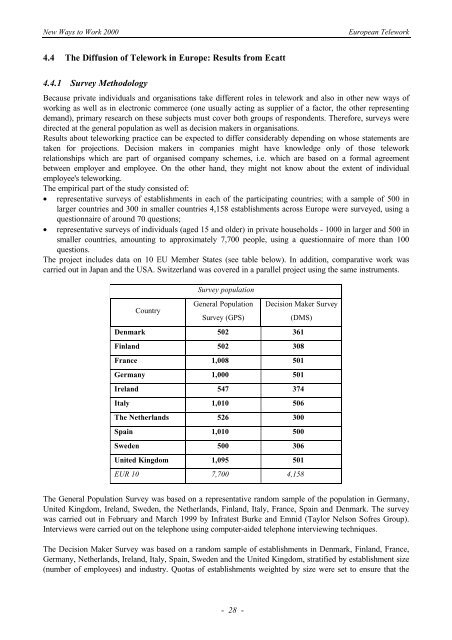eWORK 2000 - European Telework Week
eWORK 2000 - European Telework Week
eWORK 2000 - European Telework Week
- No tags were found...
Create successful ePaper yourself
Turn your PDF publications into a flip-book with our unique Google optimized e-Paper software.
New Ways to Work <strong>2000</strong><strong>European</strong> <strong>Telework</strong>4.4 The Diffusion of <strong>Telework</strong> in Europe: Results from Ecatt4.4.1 Survey MethodologyBecause private individuals and organisations take different roles in telework and also in other new ways ofworking as well as in electronic commerce (one usually acting as supplier of a factor, the other representingdemand), primary research on these subjects must cover both groups of respondents. Therefore, surveys weredirected at the general population as well as decision makers in organisations.Results about teleworking practice can be expected to differ considerably depending on whose statements aretaken for projections. Decision makers in companies might have knowledge only of those teleworkrelationships which are part of organised company schemes, i.e. which are based on a formal agreementbetween employer and employee. On the other hand, they might not know about the extent of individualemployee's teleworking.The empirical part of the study consisted of:• representative surveys of establishments in each of the participating countries; with a sample of 500 inlarger countries and 300 in smaller countries 4,158 establishments across Europe were surveyed, using aquestionnaire of around 70 questions;• representative surveys of individuals (aged 15 and older) in private households - 1000 in larger and 500 insmaller countries, amounting to approximately 7,700 people, using a questionnaire of more than 100questions.The project includes data on 10 EU Member States (see table below). In addition, comparative work wascarried out in Japan and the USA. Switzerland was covered in a parallel project using the same instruments.CountrySurvey populationGeneral PopulationSurvey (GPS)Decision Maker Survey(DMS)Denmark 502 361Finland 502 308France 1,008 501Germany 1,000 501Ireland 547 374Italy 1,010 506The Netherlands 526 300Spain 1,010 500Sweden 500 306United Kingdom 1,095 501EUR 10 7,700 4,158The General Population Survey was based on a representative random sample of the population in Germany,United Kingdom, Ireland, Sweden, the Netherlands, Finland, Italy, France, Spain and Denmark. The surveywas carried out in February and March 1999 by Infratest Burke and Emnid (Taylor Nelson Sofres Group).Interviews were carried out on the telephone using computer-aided telephone interviewing techniques.The Decision Maker Survey was based on a random sample of establishments in Denmark, Finland, France,Germany, Netherlands, Ireland, Italy, Spain, Sweden and the United Kingdom, stratified by establishment size(number of employees) and industry. Quotas of establishments weighted by size were set to ensure that the- 28 -








